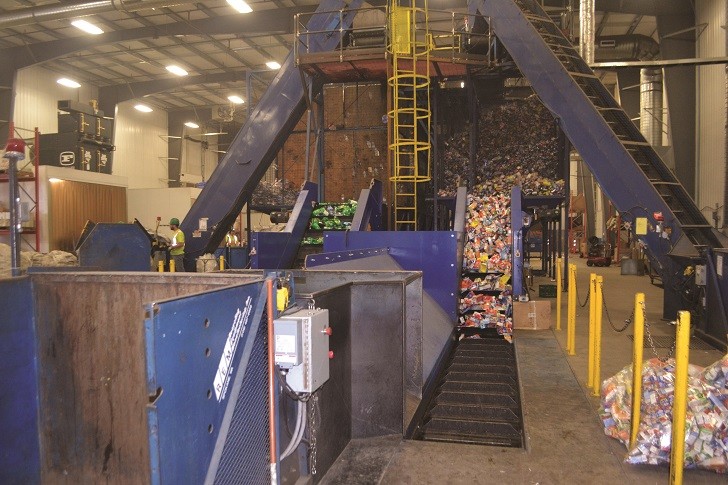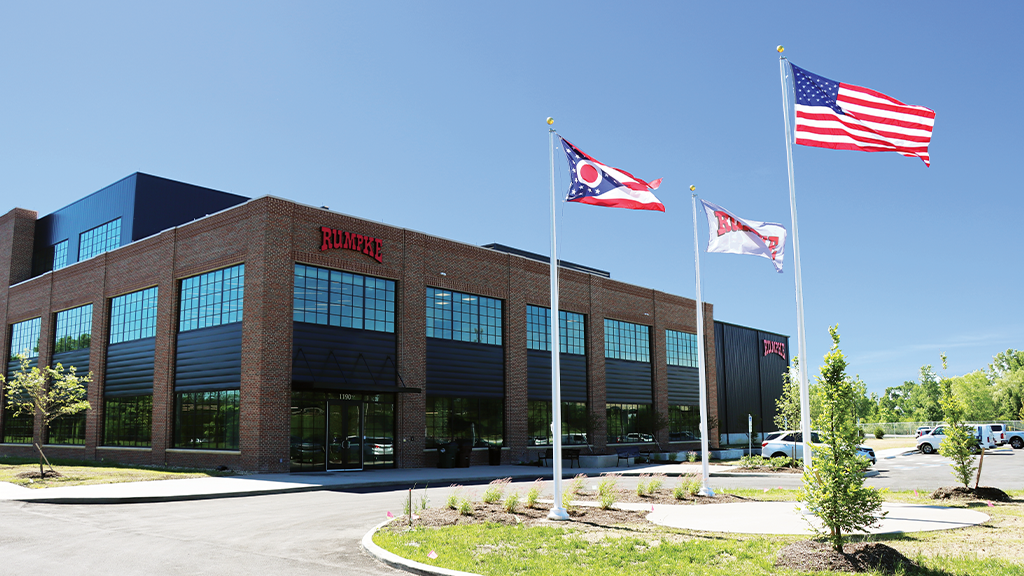“Crushing it” in Saskatchewan
SARCAN Recycling’s system for processing used beverage containers is one of the most efficient and effective in North America, handling everything from asceptics to glass

Established in 1988, SARCAN Recycling (SARCAN) was formed as a division of SARC, a company that provides basic education, training and development for people with intellectual disabilities and their supporting agencies, with the primary goal of creating employment opportunities. With a head office in Saskatoon, SARCAN Recycling has over 650 employees and operates 71 recycling depots, as well as processing plants in Saskatoon and Regina. Persons with intellectual disabilities, or those previously on social assistance, make up approximately 70 percent of SARCAN’s workforce. The company’s depots accept primarily non-refillable, one-time-use beverage containers, but do also take standard refillable beer bottles, tin and aluminum cans, plastic containers, tetra and asceptic (polycoat) containers, juice cartons, milk and glass containers, as well as used paint cans and e-waste.
“We’re a huge workforce in the province,” says Kevin Acton, SARCAN’s director of operations. “Our system is fully integrated. We own and operate all our depots, which is different than other provinces. We also operate our own transportation system and our own processing plants, and we have our own finance and administration division.”
Success and challenges in container recycling
Saskatchewan is a province with just over a million people. A “universal” deposit system, similar to the one used in B.C., is in place, where all beverage containers (excluding milk and nonrefillable glass) can be returned for refund. In 2014, SARCAN Recycling processed 406 million containers with a return rate of about 86 percent, based on all containers sold. Total metric tons of materials diverted in the same period amounted to over 20,000 metric tons.
Part of their success, including the impressive number of containers recycled, has to do with the fact that SARCAN is capable of accepting a very wide range of container types at their operations. Of course, some containers present more challenges than others when it comes to recycling. With asceptic containers, which are collected and baled, the challenge is mostly with respect to the residuals left in the container.
“There’s a lot of residual juice in the aseptic container,” says Acton. “So when you bale them there’s a lot of sticky juice and citric acid, which gets on our floors and on the equipment, and it creates some maintenance issues and concerns for us. Then the downstream market is not terrific for aseptic containers. Overall it’s just a difficult material to recycle. (Aseptic packages are typically a mix of about 70 percent paper, about 24 percent polyethylene (LDPE) and about 6 percent aluminum, with a polyethylene inside layer.)
With plastic milk containers, Acton says while they are not as difficult to recycle as asceptic containers, and provide quality, high-density plastic material with a fairly high salvage value, the challenge is similar with respect to the residuals left behind after use, and the resulting smell.
“We pre-flatten and we use air filtration, which helps a lot with the smell. But when milk containers are squeezed and baled, the air is forced out, so odour cannot be completely avoided.” When asked if washing could solve this problem, Acton simply states that they could not wash all the millions of containers received, as it would just take too long and not be cost-effective. “We do encourage the public, as part of our education/marketing campaigns, to rinse and then flatten their containers. A lot of the public is really responsive to this in Saskatchewan.”
For used paint cans, SARCAN Recycling has partnered with Product Care, the EPR organization based out of B.C., since 2006. Used paint cans are collected, consolidated onto semitrailers and shipped from a warehouse to downstream processors for recycling.
Getting past the glass
Glass is another challenging material to recycle. It is tough on equipment and the end-market opportunities are relatively sparse, if not underused. In many provinces, including parts of B.C., it is difficult to find a place for consumers to take used glass. There are simply not enough recyclers with the equipment and capability to recycle it.
For SARCAN Recycling, things are different. The company collects glass from around the province and ships it to their processing plants in either Saskatoon or Regina.
“Glass recycling is being somewhat forced in Saskatchewan,” says Acton. “Fortunately, we have a glass bead manufacturing company located out of Moosejaw, Saskatchewan. Annually we do about 20 million pounds of used glass, or about 10 million kilograms per year, using four glass crushing machines.”
SARCAN uses glass crushers manufactured by Idaho-based REM (Recycling Equipment Manufacturing) and then transports material to a privately owned local company for processing. “We’re fortunate to have an end market,” says Acton. “There are not very many glass bead manufacturers in Western Canada. Glass is heavy and it’s very abrasive so it’s difficult to deal with on a processing site. It wears out machinery quickly.
“We’ve had really good success with our REM glass crushers,” continues Acton. “We started years ago with a basic machine, and we stepped up as we moved along. We now have some fairly “beefy” GB5 model crushers. Our latest piece of REM equipment, bought in 2014, is a GB5 glass crusher with bin tipper, and is now working in our main Regina processing plant. The reason that we moved up to the GB5 was for more horsepower and the wider conveyor – for more material and more tons per hour.”
SARCAN uses two crushers to process clear glass, one in each plant, and then two crushers for coloured and mixed glass. All the glass crushers are fed using REM bin tippers
“Our bin tippers are a critical part of our glass processing equipment,” Acton says. “It gets the bins of glass up into the crusher. We have a number of them in operation in both of our plants for tipping tote bags and bins of different sizes, and have them hooked up to our plastic conveyors, and our incline conveyors. We have probably four or five bin tippers at each plant. They are a great piece of equipment, and we have been buying them from REM for almost 20 years.
“From an occupational health and safety standpoint, we used to lift all our material by hand and dump it onto the conveyor. The bin tippers will let you take a tote bag and tip it upside down and hook it in so that it does the work, instead of having the labourers do the work. It’s also a time saving feature.”
Acton says they need to crush glass before sending it downstream in order to achieve maximum capacity on the trucks it is shipped in. The REM crushers provide between 4:1 and 5:1 reduction in size, and weight goes up exponentially.
“We can load 40 tons onto a hydraulic B-train that we can send to market,” says Acton. “Our crushers allow us to do that. The GB5 does a nice job. It doesn’t break material too fine and that’s important when you’re crushing glass, because you don’t want to create silica. So it breaks it just enough to shatter the bottle and break it into pieces that are roughly half-inch to three-quarters of an inch in size.”
On the GB5 glass crusher, there are multiple wear points, standard for any glass crushing equipment. Units use a steel plate and a rolling drum powered by a low horsepower drive motor. Bottles fall between the rolling drum and the steel plate, which is thick, hardened material, but still does get worn out by glass. According to REM, both their steel plate and the rolling drum are set up in the machine so they are fairly easy to take out and replace.
We attribute our overall success to a commitment by the people of Saskatchewan to recycling, the dedication of our employees and the efficiency of our processing systems and equipment. Kevin Acton, SARCAN Recycling
“We keep extras on hand,” says Acton. “The bars on the drum are hardened steel as well, and they wear just due to the nature of the glass. We have extra drums that we order from Recycle Systems [REM’s distributor based out of Washington state] and we get them built up after they’ve been worn, and replace the drums and the steel plate. That’s just part of general maintenance on a glass crusher.”
From depot to plant, efficient equipment is key
After material is collected at one of SARCAN’s depots, it is flattened, compacted and prepared for transport to one of the company’s processing facilities.
“We flatten material before we transport it. Materials are flattened to different degrees, depending on the provincial depot location,” Acton explains. “All of our depots flatten cans and the plastics to knock the air out of them before we transport, which makes a huge difference.
“We us an Orwak flattener in our small depots, and we use larger NextGen flatteners as well. In the large depots we also designed and built some of our own multi-material flatteners.
“Once material hits our plants, it goes onto conveyors on the floor that feed directly to our balers and bin systems. Some of the conveyors, our in-floor conveyors, were manufactured by Machinex out of Quebec.
“The rest we have manufactured either locally or manufactured ourselves. We also use two large balers. We have an open-end baler and a two-ram baler. The open-end baler is made by Balemaster and the two-ram baler is made by Excel.
“The nice thing on the Excel baler is its flexibility on the auto tie system. When you’re baling plastics, you can crank it up, you can have more wires tying around the bale because of the pressure. So that’s really a nice operating feature. The Balemaster does a really nice tight, big bale. Our Excel baler is about four years old and the Balemaster is two or three. They’ve both been working well for us.”
Future looks bright
Over the summer, SARCAN Recycling has been renovating and expanding the company’s main processing plant in Regina. The facility has been operating during the construction period, which is schedulled for completion before the end of 2015.
“We’ve undergone a lot of equipment changes, with our new glass crushing lines being set up with REM crushers and our new conveyors from Machinex which are going to convey material outside. We’re also always improving our depots, and have a new one coming online sometime in the next year, in Northern Saskatchewan. There’s a lot happening at the moment. Saskatchewan is currently booming and we continue to set records. Last year was a record year for us and we’re ahead of it this year.”
In 2013, SARCAN Recycling saw their 6 billionth beverage container come through their plant.
“We’re very close to seven billion,” says Acton. “It will be middle of the winter of this year that we should crack seven billion. We have somebody that keeps an eye on that number for us.” RPN
At one of SARCAN Recycling’s more than 70 depots, material ranging from milk and aseptic containers to glass, is collected, flattened, compacted and prepared for transport and processing.
Company info
373 Shannon Lane/ PO BOX 310
Priest River, ID
US, 83856


